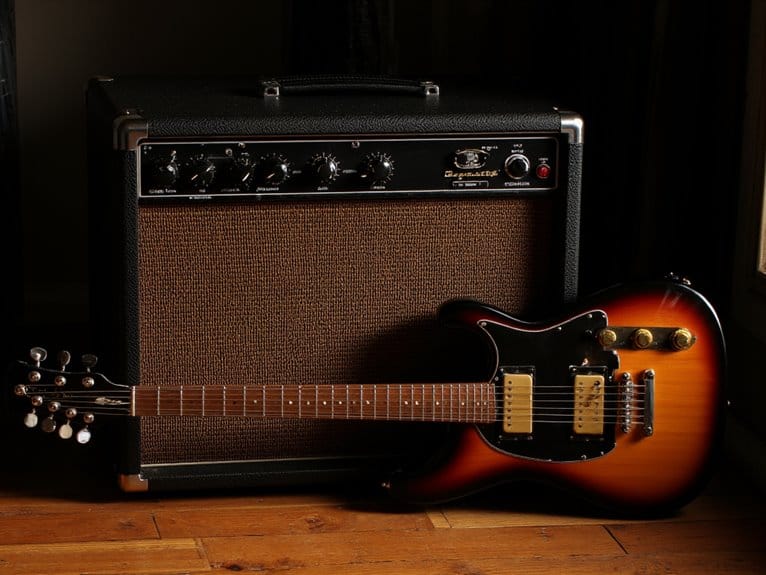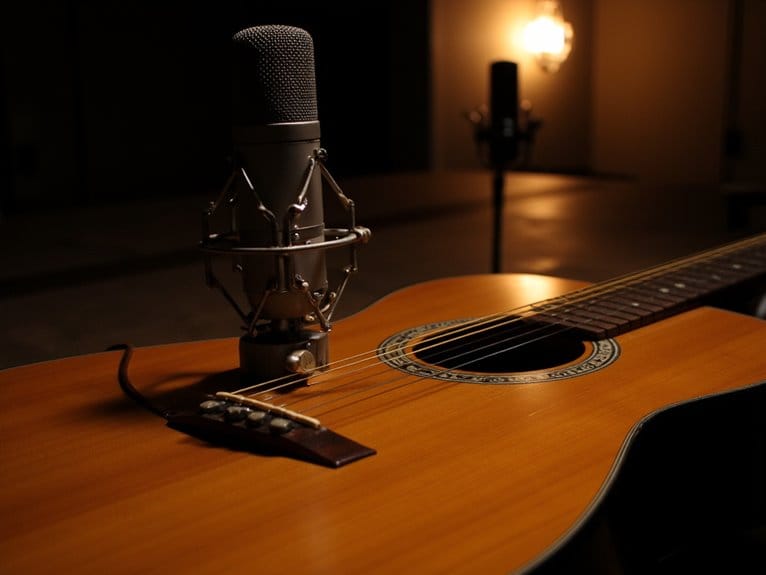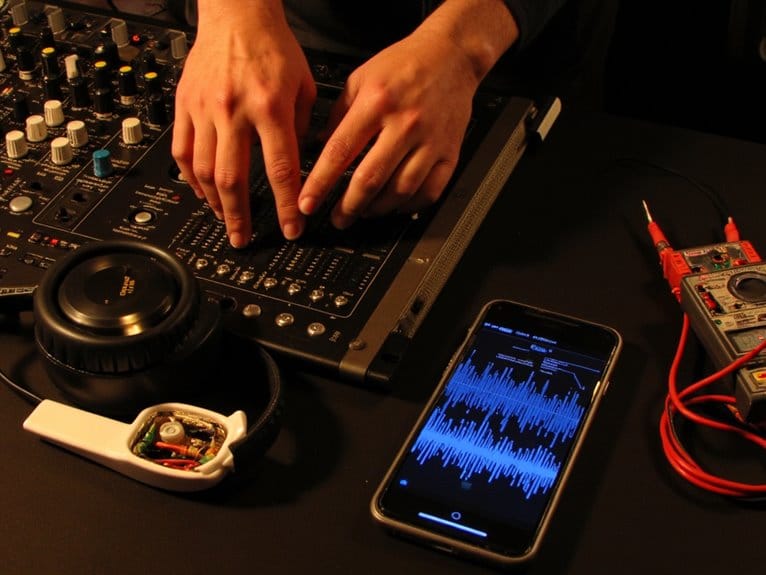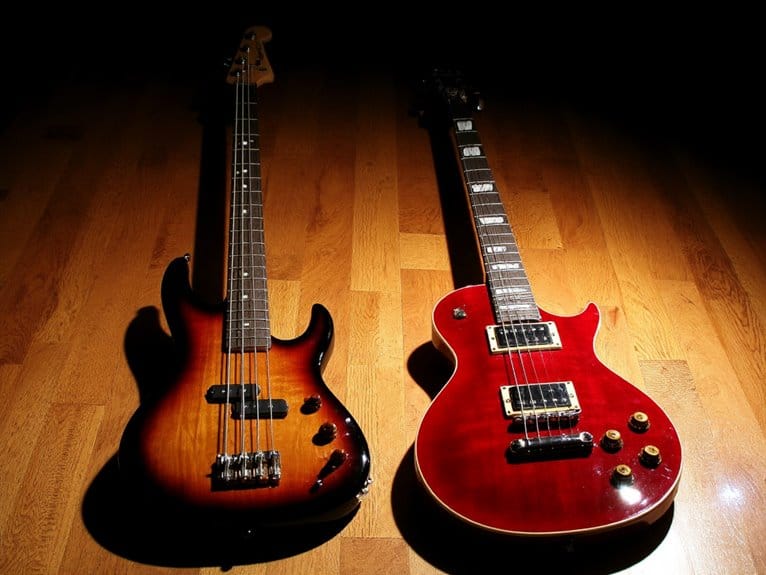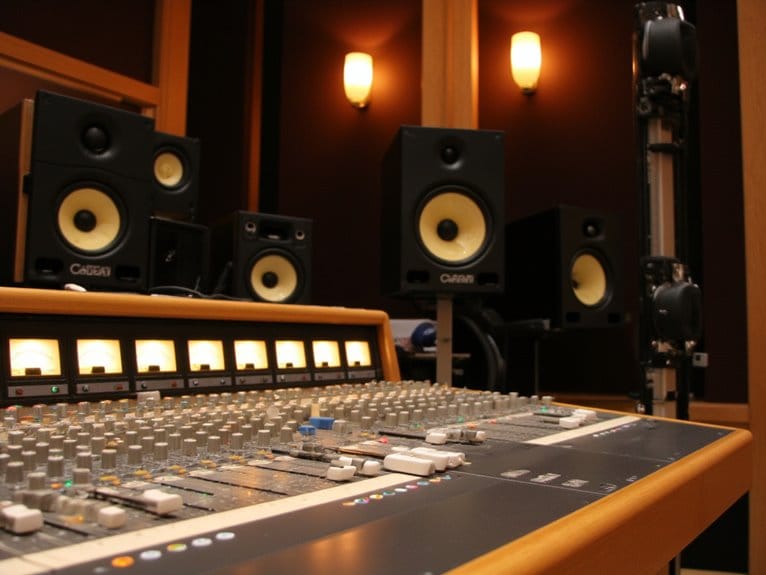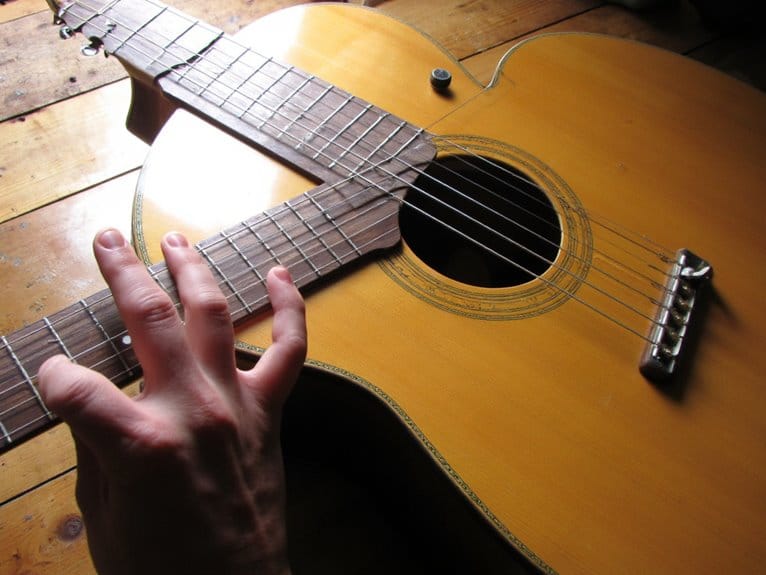Guitar Amplifier Basics: How They Shape Your Sound
Your guitar amplifier shapes sound through three key stages: the preamp captures and boosts your guitar’s signal while adding tonal character, the power amplifier increases voltage to drive speakers with varying degrees of warmth or clarity, and the speaker cabinet converts electrical energy into acoustic waves that define your final tone. Whether you’re using tube amps for natural saturation, solid-state for clean headroom, or hybrid designs for versatility, each technology responds differently to your playing dynamics and EQ adjustments, fundamentally transforming how your instrument expresses itself through careful signal processing and amplification that goes far beyond simple volume increase.
We are supported by our audience. When you purchase through links on our site, we may earn an affiliate commission, at no extra cost for you. Learn more.
Notable Insights
- The preamp section captures and boosts your guitar signal while adding character through gain control and tone coloring.
- Power amplifiers transform line-level voltage to drive speakers, with tubes providing warmth and solid-state offering clean headroom.
- Tone controls act as your sound sculpting command center, with bass, midrange, and treble shaping your guitar’s voice.
- Tube amps deliver warm, harmonically rich tones with natural compression, while solid-state amps provide reliable, clean performance.
- Speaker and cabinet design significantly impact sound dispersion, bass response, and overall frequency characteristics of your amplified tone.
The Three Core Components That Make Your Amp Work
When I first started tinkering with guitar amps decades ago, I quickly learned that beneath all the knobs, switches, and glowing tubes, every amplifier relies on three fundamental components that work together to transform your guitar’s whisper-quiet signal into room-filling sound.
Your preamp section captures that delicate signal from your input jack, boosting it while adding character through tube saturation or solid-state precision. Next, the power amplifier section takes this processed signal and cranks up the voltage and current, determining your amp’s overall amplifier efficiency and headroom capabilities. Higher wattage output provides better dynamic range and cleaner tones, influencing volume and clarity before distortion sets in.
Finally, your speaker converts all that electrical energy into acoustic waves, with cone materials and size directly affecting speaker dynamics, frequency response, and projection. The cabinet design plays an equally important role, with open-backed configurations dispersing sound widely while closed-back designs produce tighter bass response and more directional output. Modern amps also feature multiple channels that allow guitarists to switch between clean and overdriven tones instantly during performance. Pickup configuration choices, whether single-coil or humbucker, significantly impact how your amp processes the incoming signal and affects the final tonal output.
These three components form an interconnected chain where each stage influences the next, ultimately shaping your guitar’s voice.
How the Preamp Processes and Shapes Your Guitar Signal
After spending countless hours tweaking preamp settings in dingy rehearsal spaces, I’ve come to understand that the preamp serves as your guitar signal’s first crucial pit stop, where that barely-there electrical whisper from your pickups gets transformed into something with real substance and character.
Your gain control determines how hard you’re pushing those circuits, and when you crank it up, circuit overload creates those sweet distortion characteristics that define your sound signature.
The preamp’s noise filtering capabilities protect your signal clarity while maintaining dynamic range, ensuring that subtle playing nuances survive the amplification process. Professional preamps deliver zero-latency monitoring through dedicated headphone outputs to keep your timing accurate during recording sessions.
Through careful tone coloring via EQ adjustments, you’re fundamentally sculpting your voice before any effects or power amplification occurs.
Quality amplifiers maintain sound integrity across their frequency response range of 40Hz to 20kHz, ensuring your preamp’s careful signal shaping translates accurately through the entire amplification chain.
Power Amplifier Function: From Signal to Speaker
Once your preamp has shaped and boosted that initial guitar signal, the power amplifier takes over as the final heavyweight in your signal chain, transforming that line-level voltage into the serious electrical muscle needed to actually move your speaker cones. Your power amp doesn’t just make things louder—it’s fundamentally responsible for translating electrical signals into physical speaker movement that creates actual sound waves.
| Power Amp Type | Sound Dynamics | Best Application |
|---|---|---|
| Tube | Warm compression, natural saturation | Blues, rock, vintage tones |
| Solid-State | Clean headroom, tight response | Metal, jazz, high-volume clarity |
| Hybrid | Balanced warmth and reliability | Versatile gigging, studio work |
The power output of your amplifier becomes crucial when determining whether you have enough headroom for live performances, with 20+ watts typically needed to compete with other instruments in a band setting. Tube amplifiers deliver harmonic distortions that are particularly appreciated by guitarists, creating the pleasant even-order harmonics that give vintage tones their characteristic warmth and musical quality. Without proper impedance matching between your power amp and speakers, you’ll experience poor performance and potential equipment damage.
Tone Controls and Equalization Options
The tone controls on your guitar amplifier represent the creative command center where you’ll sculpt your sound from raw electrical signal into your signature voice, and honestly, I’ve seen more guitarists get overwhelmed by these knobs than I care to admit.
Your amp’s tone shaping arsenal typically includes bass, midrange, and treble controls that either boost or cut specific frequency ranges, with passive controls using simple resistor-capacitor circuits while active controls employ amplifying devices for more dramatic adjustments.
Understanding your EQ settings transforms your playing experience:
- Bass controls add warmth and fullness that makes your rhythm playing sound massive
- Midrange adjustments determine whether you cut through the mix or get buried alive
- Treble shapes your attack and sparkle, defining note clarity and presence
These controls work synergistically with your guitar’s pickups, requiring experimentation to discover your signature tone. Professional studios often utilize high-quality preamps to capture these carefully crafted tones with minimal noise and maximum detail. For modern recording workflows, an audio interface can capture these carefully crafted tones with professional quality, allowing you to preserve your signature sound in digital format.
Understanding Signal Flow Through Your Amplifier
When your guitar’s signal enters that input jack, it begins an intricate journey through multiple stages of amplification and conditioning that I’ll admit took me years to fully grasp.
Understanding this path will transform how you approach your amp’s controls and capabilities. Your signal first encounters grid stopper resistors that filter radio frequencies, then reaches the preamp tube‘s grid where initial voltage gain occurs.
Knowing your signal’s journey from input jack to preamp tube unlocks deeper control over your amplifier’s sonic potential.
The signal path continues through coupling capacitors that block DC while passing audio frequencies, travels through tone stack circuitry for frequency shaping, then hits the phase inverter which creates two out-of-phase signals for your power tubes.
Understanding this flow helps you troubleshoot issues like acoustic feedback and optimize your tone controls more effectively. The final stage involves impedance matching between your amp’s output and speaker cabinet to ensure optimal performance and prevent overheating.
Tube vs. Solid-State vs. Hybrid Technologies
When you’re choosing your next amplifier, you’ll encounter three primary technologies that each shape your tone in distinctly different ways.
Honestly, I’ve spent years comparing these approaches to help guitarists make informed decisions. Tube amplifiers deliver that coveted warm, harmonically rich sound through vacuum tubes, while solid-state amps provide clean, reliable performance using transistors.
Hybrid designs attempt to bridge both worlds by combining tube preamps with solid-state power sections. Solid-state amplifiers offer power efficiency for regular gigging with output ranges from 10-100+ watts suitable for various venue sizes. Understanding these fundamental differences in construction, tonal characteristics, and practical considerations will guide you toward the amplifier technology that best matches your playing style, budget constraints, and maintenance preferences.
While tube amplifiers excel in delivering organic compression and touch sensitivity that blues purists favor, they require periodic tube replacement and incur higher maintenance costs compared to their solid-state counterparts.
Tube Amplifier Characteristics
Five decades of guitar amplification have taught me that understanding the fundamental differences between tube, solid-state, and hybrid technologies isn’t just about technical specifications—it’s about discovering which sonic foundation will best serve your musical expression.
Tube amplifiers deliver unmatched warmth through their preamp, power amp, and rectifier stages working together, creating that coveted tube saturation and natural harmonic distortion that musicians crave.
When you push tubes hard, they produce pleasing breakup instead of harsh clipping, while their dynamic responsiveness means your playing intensity directly controls the amp’s voice.
- Natural compression smooths your transients while sustaining notes beautifully
- Bell-like harmonic complexity from EL84 tubes creates engaging musical richness
- Dynamic feel that responds intimately to your touch and playing style
Solid-state amplifiers excel at delivering pristine clean tones that preserve the guitar’s natural voice, particularly in jazz applications where maintaining articulate detail and melodic nuance is essential.
While guitarists often focus on tube characteristics, bass players require higher wattage amplifiers to achieve clean, defined tones that can cut through full band mixes without losing clarity.
Solid-State Amp Benefits
While tubes offer that beloved warmth and character, solid-state amplifiers present compelling advantages that’ve made them indispensable in my arsenal over the years, particularly when reliability, affordability, and consistent performance take priority over vintage tone.
The solid state advantages become immediately apparent when you’re lugging gear to gigs, as these amps weigh considerably less than their tube counterparts, eliminating the back-breaking transformer weight.
You’ll appreciate the performance versatility when recording at home, since solid-state amps deliver full distortion effects at whisper-quiet volumes, unlike tubes that require natural breakup. Higher wattage alone doesn’t guarantee better tone, as design and speaker quality remain equally crucial factors in achieving your desired sound.
Cost-wise, they’re budget-friendly for beginners, and the transistor circuitry operates reliably for decades without tube replacements or bias adjustments.
Many modern solid-state amplifiers incorporate built-in effects like reverb, delay, and chorus, providing extensive tonal versatility without requiring additional pedals or outboard gear.
Hybrid Technology Advantages
After decades of wrestling with the eternal tube-versus-solid-state debate, I’ve discovered that hybrid amplifiers offer the most compelling solution for guitarists who refuse to compromise on either tone or practicality.
You’ll get the warm, harmonic distortion from tube preamp stages while benefiting from solid-state power sections that deliver greater efficiency, reliability, and headroom. This combination provides performance consistency that touring musicians desperately need, alongside significant maintenance savings since you’re only replacing preamp tubes rather than expensive power tubes.
- Experience that coveted tube warmth without the constant anxiety of power tube failures during vital gigs
- Enjoy faster response and tighter bass that adapts perfectly to modern playing styles and genres
- Save hundreds of dollars annually by avoiding costly power tube replacements while maintaining authentic analog character
For apartment dwellers who need versatile tone options, hybrid amps often include built-in effects like clean, overdrive, and reverb settings that eliminate the need for additional pedals while maintaining authentic tube character.
Modern hybrid designs like those found in certain combo amplifiers demonstrate how digital modeling can complement analog tube circuits to create versatile tonal platforms that excel in both studio recording and live performance environments.
Combo Amps vs. Stack Systems: Choosing Your Configuration
When you’re standing in a music store staring at rows of amplifiers, one of the most fundamental decisions you’ll face is choosing between a combo amp and a stack system, and honestly, this choice will shape everything from your sound to your back’s wellbeing for years to come.
Combo advantages center on convenience and portability considerations—you’ll appreciate hauling one integrated unit instead of multiple components.
These systems deliver tighter, more defined tone shaping due to close amp-speaker proximity, making them perfect for home practice and smaller venues where volume preferences lean moderate.
Stack benefits shine in performance contexts requiring serious power, offering superior speaker configurations like 4×12 cabinets that produce fuller bass response and commanding stage presence.
The modular design provides extensive upgrade paths, letting you swap components independently as your needs evolve. Many combo amplifiers feature headphone outputs for silent practice sessions, allowing you to develop your skills without disturbing neighbors or family members.
For beginners exploring combo options, models like the Marshall MG10G provide authentic overdrive sound in a portable 10-watt package that’s ideal for learning fundamental amplification principles.
Frequently Asked Questions
What Wattage Amplifier Do I Need for Home Practice Versus Live Performances?
For home practice, you’ll need 1-20W amplifiers that won’t overwhelm small spaces. Live performances require 20-50W for small venues, while medium-to-large stages demand 100-300W to cut through band mix effectively.
How Do I Prevent Feedback When Playing at High Volumes?
You’ll prevent feedback by controlling your volume levels and breaking the feedback loop. Position your amp behind you, use directional mics, apply notch filters around 250-400Hz, and keep speakers away from your guitar’s pickups.
What’s the Difference Between an Amplifier’s Master Volume and Preamp Gain?
Preamp gain controls your signal’s distortion level by adjusting input strength, while master volume manages overall loudness without changing tone character. This preamp function versus master control separation lets you dial distortion independently from volume.
On a final note
Now you’ve got the foundation to understand how your amplifier transforms that simple guitar signal into the sound that fills the room. Whether you’re drawn to the warm saturation of tubes, the reliability of solid-state circuits, or the versatility of hybrid designs, you’ll make better choices knowing how preamps, power sections, and tone controls work together. Your sound starts here.

